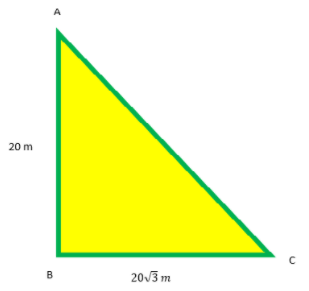
In the figure given below, a tower AB is 20 m high and BC, its shadow on the ground is $20\sqrt 3 m$ long. Find the distance of the tip of the tower from point C.


Answer
577.5k+ views
Hint: We will use the Pythagorean theorem to find the length of AC because the tip of the tower is A and we need to find its distance from C. Thus, we will have the answer as required.
Complete step-by-step answer:
Since, AB is given to be the tower, it must be straight and perpendicular to the ground.
Hence, we will have $\angle B = {90^ \circ }$.
Now, we know that if we have a right angled triangle with base and perpendicular being a and b, then its hypotenuse c can be given by:- ${c^2} = {a^2} + {b^2}$ .
This is known as the Pythagorean Theorem.
Hence, using the same thing in the given question, where base = BC, Perpendicular = AB and the hypotenuse as AC.
So, we will get:-
$A{C^2} = A{B^2} + B{C^2}$
Putting the values as: $AB = 20m$and $BC = 20\sqrt 3 m$, we will get:-
$A{C^2} = {20^2} + {(20\sqrt 3 )^2}$
This will imply that:-
$ \Rightarrow A{C^2} = (20 \times 20) + (20\sqrt 3 \times 20\sqrt 3 )$
Simplifying by multiplying the values required, we will get:-
$ \Rightarrow A{C^2} = (400) + (400 \times 3)$
Simplifying it further, we will get:-
$ \Rightarrow A{C^2} = 400 + 1200$
This will imply:-
$ \Rightarrow A{C^2} = 1600$
Taking square root on both the sides, we will get:-
$ \Rightarrow AC = \sqrt {1600} m = 40m$
Hence, the required distance between the tip of the tower A to the point C is 40 meters approximately.
Note: The students must notice that there is one more way to approach the same problem. The way is:- First they should calculate the value of $\tan C$ using the values given and the formula:$\tan C = \dfrac{{Perpendicular}}{{Base}}$ and then using some other trigonometric function which includes the side AC that is hypotenuse in it, and thus we will get the required value of AC.
Fun Fact:- Trigonometry allows you to convert one length to another if you know the angle between them. With trigonometry and a tool called a clinometer you can measure the height of tall objects you’d never be able to measure directly. Eratosthenes measured the Sun’s angle at two places in Egypt and used trigonometry to calculate the Earth’s radius.
Complete step-by-step answer:
Since, AB is given to be the tower, it must be straight and perpendicular to the ground.
Hence, we will have $\angle B = {90^ \circ }$.
Now, we know that if we have a right angled triangle with base and perpendicular being a and b, then its hypotenuse c can be given by:- ${c^2} = {a^2} + {b^2}$ .
This is known as the Pythagorean Theorem.
Hence, using the same thing in the given question, where base = BC, Perpendicular = AB and the hypotenuse as AC.
So, we will get:-
$A{C^2} = A{B^2} + B{C^2}$
Putting the values as: $AB = 20m$and $BC = 20\sqrt 3 m$, we will get:-
$A{C^2} = {20^2} + {(20\sqrt 3 )^2}$
This will imply that:-
$ \Rightarrow A{C^2} = (20 \times 20) + (20\sqrt 3 \times 20\sqrt 3 )$
Simplifying by multiplying the values required, we will get:-
$ \Rightarrow A{C^2} = (400) + (400 \times 3)$
Simplifying it further, we will get:-
$ \Rightarrow A{C^2} = 400 + 1200$
This will imply:-
$ \Rightarrow A{C^2} = 1600$
Taking square root on both the sides, we will get:-
$ \Rightarrow AC = \sqrt {1600} m = 40m$
Hence, the required distance between the tip of the tower A to the point C is 40 meters approximately.
Note: The students must notice that there is one more way to approach the same problem. The way is:- First they should calculate the value of $\tan C$ using the values given and the formula:$\tan C = \dfrac{{Perpendicular}}{{Base}}$ and then using some other trigonometric function which includes the side AC that is hypotenuse in it, and thus we will get the required value of AC.
Fun Fact:- Trigonometry allows you to convert one length to another if you know the angle between them. With trigonometry and a tool called a clinometer you can measure the height of tall objects you’d never be able to measure directly. Eratosthenes measured the Sun’s angle at two places in Egypt and used trigonometry to calculate the Earth’s radius.
Recently Updated Pages
Two men on either side of the cliff 90m height observe class 10 maths CBSE

What happens to glucose which enters nephron along class 10 biology CBSE

Cutting of the Chinese melon means A The business and class 10 social science CBSE

Write a dialogue with at least ten utterances between class 10 english CBSE

Show an aquatic food chain using the following organisms class 10 biology CBSE

A circle is inscribed in an equilateral triangle and class 10 maths CBSE

Trending doubts
Why is there a time difference of about 5 hours between class 10 social science CBSE

Write a letter to the principal requesting him to grant class 10 english CBSE

What is the median of the first 10 natural numbers class 10 maths CBSE

The Equation xxx + 2 is Satisfied when x is Equal to Class 10 Maths

Which of the following does not have a fundamental class 10 physics CBSE

State and prove converse of BPT Basic Proportionality class 10 maths CBSE




